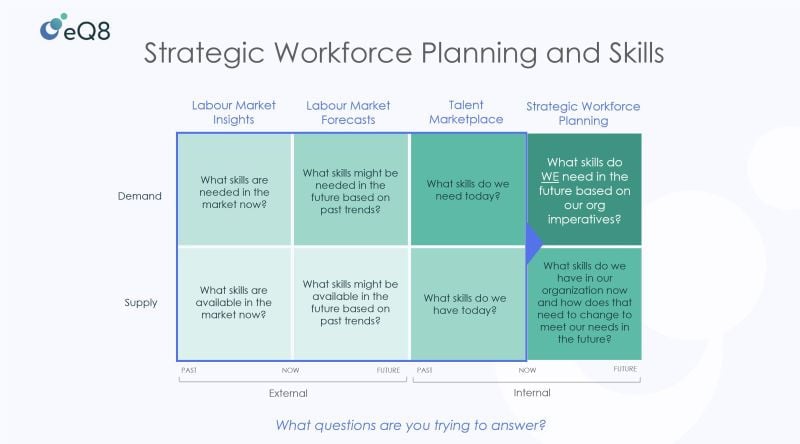Skills and Strategic Workforce Planning

It is fair to say that all things skills are top of mind for organizations across the globe. With 79% of CEO's concerned about skill availability according to PwC, we have all become a little skill-obsessed.
But how do you solve the skills conundrum? It can be confusing with all the cool data and tech out there - so it really depends on what questions you are trying to answer. For us at eQ8, the biggest question is: how do you know what skills matter for YOUR organization? This is not data that you can just get from an external benchmarking source or infer from labor market job postings. To work out what YOUR organization needs to deliver its transformation, growth, digitization or change agenda, you need to integrate external skill insights with internal demand forecasting through Strategic Workforce Planning. For more insights, see the video below.
Prefer to read? Jump to the transcript below.
Skills and SWP
This transcript has been lightly edited for clarity.
Where to start on the skills journey
Something which is top of mind for most of us these days are skills and understanding the needs of our organizations now and into the future. I think it's important that that is where the focus is, because skills are a key enabler for organizations to achieve their agenda and purpose. Whether it's growth, digitization, transformation or change, skills are the make or break for your organization and no longer can we just passively sit by and assume the skills will just materialize for us. We need to understand what we need and when so that we can make sure that we have those in place that we're risk mitigating our organization's ability to do what it needs to do.
So, there's a bit of confusion about how we understand what skills our organization needs in the future, so I just wanted to touch on a few different things that are floating around out there at the moment. From a perspective of skills, we have two components. We have the demand or what we need from a skill perspective and supply, which is what we've got. What currently is in our workforce and how that needs to shape and shift into the future?

Understanding Labor Market Insights and Forecasts
When we look at demand and what skills are needed in the market now, that typically comes from understanding things like job postings that have been historically placed and where job postings are up till today. So that gives us a bit of a lagging indicator in terms of understanding the market demand for skills.
We can also understand what skills are available in the market right now through that kind of insight, and we call that category of questioning labor market insights. Then we look at what skills might be needed in the future, and that's typically from an external perspective based on past trends.
So, we're looking at how skills have shaped and shifted in terms of the demand, and we're forecasting that forward. The same applies with supply, so we're looking at what the skill supply has been, how that's shaped and shifted in the past so we can again extrapolate that and infer that future-looking view of what skills are needed. We call that labor market forecasts.
Evaluating the Talent Marketplace
If we look internally, what is the organization looking to hire for, and what skills do we have today? We call that talent marketplace. Typically, that understanding comes from where we are today, what we need and what we've got. Where are the open requisitions we can't fill internally, and how do we understand how that sits and fits against our internal current state? Today, that also integrates a past perspective and how that's shaped and shifted from the past to where we are now.
Completing the picture with Strategic Workforce Planning
If we want to understand what skills our organization needs in the future based on our strategic and operating imperatives and skills, what we have in our organization and how that needs to change to meet those imperatives, we do that through strategic workforce planning.
